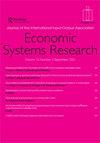日本参与全球价值链:将IO表划分为出口生产和内销生产
IF 1.6
4区 经济学
Q2 ECONOMICS
引用次数: 3
摘要
本文考察了日本参与全球价值链的情况。为此,我们使用日本的工厂级数据,将日本制造业中每个行业的产出分为出口产出或内销产出,并创建了一个扩展的多国投入产出表(MIOT)。然后,我们计算了贸易增加值(TiVA)指标,以检验日本制造工厂在全球价值链中的参与情况。我们的估计表明,日本对全球价值链的前瞻性参与低于传统工业物联网计算的估计值。我们推断,这一结果是由于高度的跨境生产碎片化,以及日本跨国公司在全球制造业中的大量存在,以及日本制造业的大量公司内部贸易。我们的结论是,考虑企业出口和内销生产的异质性可以更准确地理解全球生产碎片化。本文章由计算机程序翻译,如有差异,请以英文原文为准。
Japan’s participation in global value chains: splitting the IO table into production for export and domestic sale
This paper examines Japan’s participation in global value chains (GVCs). To this end, we use plant-level data for Japan to split output in each industry in Japan’s manufacturing sector into output for export or domestic sale and create an extended multi-country input–output table (MIOT). We then compute trade in value added (TiVA) indicators to examine the participation of Japanese manufacturing plants in GVCs. Our estimates suggest that Japan’s forward participation in GVCs is lower than suggested by estimates computed from a traditional MIOT. We infer that this result is due to high cross-border production fragmentation as well as the large presence of Japanese multinational companies in global manufacturing and the high volume of intra-firm trade in Japan’s manufacturing sector. We conclude that considering firm heterogeneity in production for export and domestic sale in MIOTs provides a more accurate understanding of global production fragmentation.
求助全文
通过发布文献求助,成功后即可免费获取论文全文。
去求助
来源期刊

Economic Systems Research
ECONOMICS-
CiteScore
5.60
自引率
4.00%
发文量
17
期刊介绍:
Economic Systems Research is a double blind peer-reviewed scientific journal dedicated to the furtherance of theoretical and factual knowledge about economic systems, structures and processes, and their change through time and space, at the subnational, national and international level. The journal contains sensible, matter-of-fact tools and data for modelling, policy analysis, planning and decision making in large economic environments. It promotes understanding in economic thinking and between theoretical schools of East and West, North and South.
 求助内容:
求助内容: 应助结果提醒方式:
应助结果提醒方式:


